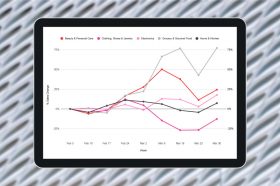Resources - Blog
How to Adjust Your E-Commerce Marketing Strategy to COVID-19

Stay on top of the latest e-commerce and marketplace trends.
The COVID-19 pandemic is the most impactful event since the end of World War II (at least on a global scale), and to say it has added complexity to the world of business would be a colossal understatement.
As far as marketing is concerned, there is no shortage of opinions from some of the industry’s most incisive voices — from those that call for caution and contraction to those espousing the virtues of investing more in marketing while everyone else goes defensive.
JP Hanson puts it best by simply pointing out that a binary approach is probably not the way to see this new situation. It depends on the brand in question, its industry, its niche, its market, and myriad other factors that are in constant flux as the global COVID-19 crisis evolves.
One thing is for sure: E-commerce marketers simply cannot afford to ignore COVID-19. You need to adapt your entire marketing strategy to this new situation and you must do so in a thorough, mindful way.
Reconsider Your Data
Your pre-coronavirus e-commerce marketing strategy was likely based on a specific set of data you collected and analyzed, which led you to certain conclusions that you then used to formulate your strategy. Quite simply, trying to adapt your strategy without considering how much of this data has changed would be illogical — and in e-commerce, a lot has changed.
For one, the unprecedented circumstances have directly caused various categories of products to become more or less popular than before the pandemic. This great article shows how certain categories saw a rise in sales on Amazon (beauty and personal care; grocery and gourmet food; later electronics), while others took a hit (clothing, jewelry).
While your particular niche may not have been impacted in such a big way, the numbers have definitely changed. It should be pointed out here that the long-term effects of the pandemic cannot yet be predicted, making it even more difficult to come up with any failsafe projections for the future (more on long-term strategy later).
Market segments have also changed. Let’s take a company selling at-home workout equipment as an example. Pre-coronavirus, the company might have zeroed in on a market segment of, let’s say, stay-at-home parents and seniors. All of a sudden, its market segment should include, well, pretty much everyone. This alone is enough to throw off all of your numbers that your strategy was based on.
You must revise your numbers. It goes without saying that the COVID-19 pandemic has also disrupted many e-commerce companies’ manufacturing and supply chains, dramatically affecting their finances and, thus, their marketing budgets. Pricing strategies that you also included in your overall marketing strategy pre-pandemic need to be reexamined and, more likely than not, reworked.
In short, you need to pretty much redo your entire data collection and analysis process and rethink the very cornerstones of your marketing strategy.
Short-Term vs. Long-Term Strategies
Balancing the short-term and the long-term is always challenging when coming up with a marketing strategy. Like everything else these days, the pandemic has made this even more difficult, and for a number of reasons.
For one, no one knows exactly how long the COVID-19 pandemic will last or how the global situation will develop. There are a number of valid theories and models, but at the moment, no one knows how long we will be dealing with the virus and how long it is going to disrupt everything around us. Not even knowing what the word “long-term” entails is alone enough to make your head spin.
Another factor that makes it difficult to plan a long-term marketing strategy in the current climate is that there is no way to predict what the market will look like two weeks from now, let alone a couple of months from now.
How many more people may lose jobs before July or August? Will there be another spike in COVID-19 cases, causing additional lockdown periods? What if the current course of opening up states and entire countries backfires? What if other countries that your supply chain depends on are strongly affected (again)? What if something hitherto unexpected happens to global finances, affecting your target market adversely?
You might also be pushed by the short-term situation to, for example, offer big discounts so as to offset a drop in sales. How will this reflect on your brand in the long term?
In addition, you might decide to make a short-term reduction in advertising due to a bad financial situation caused by COVID-19. Will this jeopardize your market share in the long term? Perhaps you might want to make a big short-term push in advertising in order to increase your market share for the long term?
The point of these questions is not to cause a panic attack. They are meant to illustrate how unprecedented this situation is and how complicated it is to come up with a semblance of a long-term strategy.
There are just too many options and you need to keep them all on the table. Analyze your current position and how you might improve it in both the short term and long term. You might find that your situation calls for conservative thinking or you might realize that this is the time to take advantage of your competitors reducing their marketing spend and increase your brand’s presence.
Rethink Your Channels
One of the crucial decisions you must make when coming up with an e-commerce marketing strategy is which channels to use to reach your market segment and best share your message. As you might expect, the new market situation carries with itself the need to rethink the channels you decided on pre-coronavirus.
For example, you may have only sporadically used large online marketplaces such as Amazon, Walmart, and eBay as an addition to your on-site selling and marketing. In the current climate, you might realize that these channels deserve more of your attention as your particular product category is seeing a massive increase in demand on those marketplaces. You might even find that certain services you never considered using before now make a lot of sense for your business, like Amazon DSP, for instance.
It goes without saying that, for some brands, the opposite will be true. Certain brands may find that the expanding market segment they are now targeting may require more information on products they did not use to purchase online. They might come to the conclusion that comprehensive, custom-designed product detail pages may be a better way to drive ROI.
You might also find out that it now makes sense to put more money in paid ads, as other brands are reducing their marketing spend and it becomes more affordable than ever before to throw your hat in the game on keywords that had once been out of your reach. It might also be possible that the new-fangled situation has expanded the pool of keywords you can compete for, providing you with an added reason to increase your spend on this channel.
Social media may also require added attention due to changing circumstances. More people may be considering your products, and you need to be there to answer any and all questions they may have. In other words, whereas you only may have used social media for branding in the past, it may become a focal point of your customer relationship efforts. If done well and sensitively, this can be a great way to boost your brand during the COVID-19 pandemic.
Be Careful About Your Message
While we are on the subject of sensitivity, there have been few (if any) recent periods when it was more important to be sensitive about the message you send as a brand.
Everywhere you look, you see brands failing at this (including big ones that usually do these things well), bombarding their customers with inappropriate messages that come across as self-serving or even callous.
People do not care that an e-commerce brand that sells decorative rugs is “there for them” and “supporting them through these tough times.” What does that even mean? They may have lost someone to COVID-19, their loved ones might be doctors or nurses, or they might themselves be essential workers who have been risking their lives through all of this. Such messages risk rubbing customers the wrong way and can inadvertently damage your brand.
Your customers and your potential customers know very well what kind of times they are living in and they understand that you are serving them your message in order to sell more of your product. Respect your customers and be mindful of their potential hardships.
Of course, if COVID-19 is affecting your company in a way that will make consumers’ experience with your brand different (such as longer fulfillment times, increased shipping prices, out-of-stock issues, among others), let them know that this is the case. Be upfront and helpful, but not solely self-serving.
Final Thoughts
The COVID-19 pandemic is a once-in-a-generation event (hopefully) and coming up with a winning e-commerce marketing strategy in light of it is not an easy task. In situations like this, it is best to go back to the basics, look at your data, re-crunch the numbers and be meticulous with your budget and the expected effects of making changes to your strategy.
It is hard work, but it has to be done. As a marketer, you have a responsibility to revise your strategy and to find the best way to help your brand navigate both short-term and long-term.
Feedvisor is continuing to monitor the events unfolding around the COVID-19 pandemic. Reference our COVID-19 resource center for ongoing coverage and updates about the crisis’s impact on Amazon and e-commerce businesses.
Learn what Feedvisor can do for your business.
When you partner with Feedvisor, you automatically receive access to our true, AI-driven technology and hands-on team of e-commerce experts. Contact one of our team members today to learn more about our end-to-end solution for brands and large sellers on Amazon, Walmart, and e-marketplaces.




